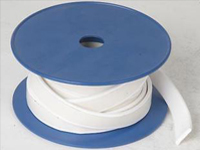Expanded PTFE Joint Sealant is a high-performance sealing material made from polytetrafluoroethylene (PTFE) that has been expanded to create a flexible, fibrous structure. This unique manufacturing process results in a tape or cord sealant that is exceptionally resistant to chemicals, extreme temperatures, and pressure. Unlike conventional sealants, it does not harden, crack, or become brittle over time, making it an ideal long-term solution for preventing leaks in a wide range of industrial applications, including pipes, flanges, valves, and pumps in demanding environments.
Our Expanded PTFE Joint Sealant is engineered to meet the highest standards of performance and reliability. Below are the detailed specifications presented in both a list and a table for clarity.
| Property | Test Standard | Typical Value / Range |
|---|---|---|
| Specific Gravity (Density) | ASTM D792 | 0.4 - 0.8 g/cm³ |
| Tensile Strength | ASTM D638 | 15 - 25 MPa |
| Elongation at Break | ASTM D638 | 100% - 400% |
| Continuous Service Temperature | ASTM D5306 | -268°C to +315°C |
| Melting Point | ASTM D4591 | 327°C (621°F) |
| Compression Set (22 hrs @ 25°C) | ASTM D395 | < 15% |
| Chemical Resistance | N/A (Inherent Material Property) | Resistant to virtually all chemicals |
| Coefficient of Friction | ASTM D1894 | 0.05 - 0.10 (Static) |
| Water Absorption | ASTM D570 | < 0.01% |
| Flammability | UL 94 | V-0 |
Expanded PTFE Joint Sealant is versatile and is used across numerous industries due to its unmatched sealing capabilities. Its primary function is to create a secure, leak-free seal between mating surfaces in equipment and piping systems. The applications include but are not limited to:
Choosing our Expanded PTFE Joint Sealant provides significant operational and maintenance benefits. Its superior material properties translate directly into enhanced performance and cost savings.
What is the main difference between expanded PTFE and regular PTFE tape?
Regular PTFE tape (often used for pipe threads) is a sintered, non-porous film that is thin and used primarily as a lubricating sealant for threaded connections. Expanded PTFE Joint Sealant is a soft, highly flexible, and fibrous material created by expanding PTFE, which gives it superior compression, recovery, and sealing capabilities for flange faces, large gaps, and irregular surfaces under high pressure and temperature.
How do I install the Expanded PTFE Joint Sealant correctly?
For tape, clean the flange surfaces thoroughly. Start wrapping the tape from the inner diameter of the flange, stretching it slightly and overlapping each wrap by about 50%. Continue until the entire flange face is covered. For cord, press the cord into the groove or around the flange bolt circle, ensuring it sits evenly. When bolting the flanges together, use a crisscross bolt tightening pattern and torque to the manufacturer's specifications to ensure an even compression and a perfect seal.
Can Expanded PTFE be reused after disassembly?
In many cases, yes. Because Expanded PTFE has excellent recovery properties, the seal can often be reused if it is not damaged, contaminated, or overly compressed. However, for critical applications, it is always recommended to install a fresh seal to guarantee optimal performance and safety.
Is this sealant suitable for oxygen service?
Yes, it is an excellent choice for oxygen and other high-purity gas services. Its inherent chemical inertness and low particle generation make it safe and reliable for such applications. Always ensure the material is clean and handled in a contaminant-free environment when used in oxygen systems.
What is the shelf life of Expanded PTFE Joint Sealant?
The shelf life is virtually indefinite if stored properly. It should be kept in its original packaging, away from direct sunlight, excessive heat (above 50°C / 122°F), and sources of contamination. The material does not degrade over time.
How does it perform with steam applications?
It performs exceptionally well in steam service. Its high-temperature resistance and non-stick properties prevent it from bonding to flange surfaces, making disassembly straightforward. It maintains its seal integrity even with the thermal cycling typical in steam systems.
Can it be used on irregular or damaged flange surfaces?
Yes, one of the key advantages of Expanded PTFE is its ability to conform to surface imperfections, scratches, or warping. It effectively fills gaps and creates a seal on surfaces that would cause other gasket materials to fail.
Is it electrically conductive?
No, Expanded PTFE is an excellent electrical insulator. If static dissipation or electrical conductivity is required for your application, special carbon-filled or other conductive versions are available.
Does it require a sealant or adhesive?
No, it is a self-contained sealing material and does not require any additional pastes, adhesives, or lubricants to function. Using such products can contaminate the seal and reduce its effectiveness.
What standards does your product comply with?
Our Expanded PTFE Joint Sealant is manufactured to meet various international standards, including ASTM, DIN, and ISO. It is also compliant with FDA regulations 21 CFR 177.1550 for indirect food contact and is often used in compliance with API, ASME, and other industry-specific standards.

